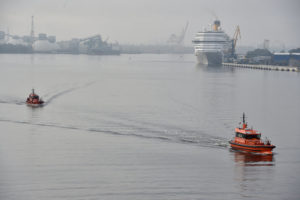
The Freeport of Riga Authority sets its focus for 2018 on the retention of its position on existing markets and on an active work in the new regions, such as India and Iran, in order to attract new cargo and passenger flows as well as investments to the port, informs the press service of the major Latvian port.
Edgars Suna, Marketing Director of the Freeport of Riga Authority, said: “In 2018, we will definitely maintain a strategic focus on our traditional major target markets: Russia, Belarus, Ukraine, Kazakhstan, Central Asia and China.”
Among these, Mr. Suna emphasizes the importance of Belarus and the efforts of the port, the Ministry of Transport and Latvian Railways (JSC “Latvijas Dzelzcels”, or LDz) to bring its volumes: “There are clear objectives set for the sector and a good opportunity for the Port of Riga to compete with the port of Klaipeda for attraction of Belarusian cargo flows.”
Talking about the alternative markets, Edgars Suna highlights that the Port of Riga is being actively promoted in India and Iran as a logistics center for the distribution of goods in the Baltic States, Scandinavia and the Nordic countries. And there is already a clear interest on the part of Indian entrepreneurs and officials in developing such a logistics center to export Indian goods into the markets of Northern Europe, Russia and the CIS countries. This may well be intensified by the cooperation agreement signed in 2017 between LDz and the Indian Railways.
Iran, which plays an important role as a transit country for Indian cargo destined to the Northern Europe, is interested, as well as Latvia, in the development of the North-South transport corridor between India and the Northern Europe. At the end of 2017, LDz Logistika Ltd and Iranian railway freight logistics company signed a cooperation memorandum, which provides for the development of new routes from India and Iran and also sets new challenges for the Riga port as an important section for this transport corridor.
With regards to passenger traffic, Riga targets at ferry and cruise line major operators: Sweden, Germany, Finland, USA, Spain, Italy, and Norway. But the port is also interested in attracting Asian cruise operators, especially from China, where the cruise tourism has been developing very rapidly in recent years.
In 2017, the throughput of Riga declined by 9.2%, to 33.7 mln tons, mostly due to a 11.4% drop in coal handling (11.8 mln tons) and a 30% fall in liquid bulk volumes (5.7 mln tons). Partly, it can be explained by a reduction of the Russian coal and oil products shipments noted last spring. As we wrote earlier, since mid-April the cargo flow from Russia has dropped by 45-50% from the budget. This is confirmed by the recently published port’s statistics: if in March 2017 the total dry bulk throughput was 2.127 mln tons, in April it was 1.969 mln tons, in May down to 1.527 mln tons and till the year end its monthly average was not exceeding 1.650 mln tons.
Transit volumes from to Russia and CIS countries make up for about 80% of the port’s throughput.
The port’s container traffic, however, increased: 445,984 TEU, +15.6%.
